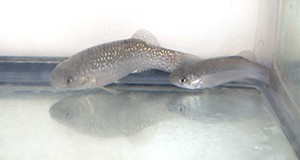Marine ornamental fish production is still in its infancy compared with its freshwater counterpart. About 1,800 wild-caught fish species are imported into the United States each year, clear proof of the need for the expansion of marine ornamental production to include new species and families of fish. Distinct behavior and a wide range of colors makes fish from the Blenniidae family, called blennies, a popular choice in the aquarium hobby. These hardy fish are small and rarely aggressive to other reef species and they eat algae and clean tank substrate. This 6-page fact sheet written by Jesse Von Linden, Joshua T. Patterson, Cortney L. Ohs, and Matthew A. DiMaggio and published by the UF/IFAS Program in Fisheries and Aquatic Sciences, School of Forest Resources and Conservation provides a brief overview of the family including description and taxonomy, natural history, culture techniques, a bit about disease challenges, and advice on marketing for ornamental Blennids.
https://edis.ifas.ufl.edu/fa225
Tag: Joshua T. Patterson
Aquaculture Applications of the Family Gobiidae
Marine ornamental fish production is still in its infancy compared with its freshwater counterpart. About 1,800 wild-caught fish species are imported into the United States each year, clear proof of the need for the expansion of marine ornamental production to include new species and families of fish. The family Gobiidae is the fourth most imported family of marine ornamental fish. Gobies can be easily housed with a variety of other species of fish. Several have qualities that lend themselves to aquarium life. Some clean other fish and others sift the sand bed. Many naturally perch on the rockscape or corals, spending their time beautifying their surroundings with their bright colors and intriguing behavior. This 7-page fact sheet written by Jesse Von Linden, Joshua T. Patterson, Cortney L. Ohs, and Matthew A. DiMaggio and published by the UF/IFAS Program in Fisheries and Aquatic Sciences, School of Forest Resources and Conservation provides a brief overview of the family including description and taxonomy, natural history, culture techniques, a bit about disease challenges, and advice on marketing for ornamental Gobids.
https://edis.ifas.ufl.edu/fa226
Overview of Urban Aquaculture
This 6-page fact sheet written by Emily H. Roan, Laura Tiu, Roy P.E. Yanong, Matthew A. DiMaggio, and Joshua T. Patterson and published by the UF/IFAS Program in Fisheries and Aquatic Sciences, School of Forest Resources and Conservation provides introductory information for people interested in engaging in commercial or hobby-scale aquaculture in urban or suburban areas. It introduces three common types of urban aquaculture systems, describes the resources and challenges unique to urban aquaculture, and includes a handy “getting started” section.
http://edis.ifas.ufl.edu/fa217
A Guide to Common Stony Corals of Florida
Shallow-water coral reefs have seen large declines in coral cover over the last 40 years. This 19-page guide written by Joseph A. Henry, Roy P. E. Yanong, Maia P. McGuire, and Joshua T. Patterson and published by the UF/IFAS Program in Fisheries and Aquatic Sciences of the School of Forest Resources and Conservation describes Scleractinian (stony) corals that were once prevalent on reefs in Florida. The Coral Reef Protection Act in Florida prohibits damaging coral reef habitats in any way, and several of these species are federally protected under the Endangered Species Act. In their natural environment, these corals should never be handled or touched. Although several of the species discussed here are growing more numerous due to their wide tolerance, the overall condition of coral reefs along our coastline is declining, and the reefs are highly threatened because the most important reef-building corals are in a state of decline.
http://edis.ifas.ufl.edu/fa210
Coral Reef Conservation Strategies for Everyone

Corals are small animals related to jellyfish. Large groups of these animals live together and form huge interconnected colonies called reefs. Coral reefs are some of the most diverse ecosystems on the planet; an essential habitat for a wide variety of animal and plant species. About 400 million people rely on coral reef fish as a source of protein; about 6 million people make a living by catching and selling coral reef fish and invertebrates; tourism activities like SCUBA diving and snorkeling provide revenue of US$9.6 billion per year; and reefs reduce wave energy by 97%, helping to protect 197 million people in coastal areas from beach erosion, wave energy, and flooding. Learn how you can help protect these fragile, essential ecosystems from threats in this 7-page fact sheet written by Kathryn E. Lohr and Joshua T. Patterson and published by the Program in Fisheries and Aquatic Sciences, School of Forest Resources and Conservation.
edis.ifas.ufl.edu/FA199
Candidate Species for Florida Aquaculture: Gulf Killifish, Fundulus grandis

The Gulf killifish is a promising species for commercial aquaculture in Florida with the potential to help diversify the marine baitfish aquaculture industry in Florida and throughout the southeastern United States. Methods for culturing this species have improved in the past decade; this 6-page fact sheet describes the new methods and some strategies to give producers greater control of reproduction, larval growth, and survival. The publication provides the information producers need to make the most informed decision possible when considering Gulf killifish aquaculture. Written by Shane W. Ramee, Joshua T. Patterson, Cortney L. Ohs, and Matthew A. DiMaggio and published by the Program in Fisheries and Aquatic Sciences, School of Forest Resources and Conservation.
http://edis.ifas.ufl.edu/fa190



